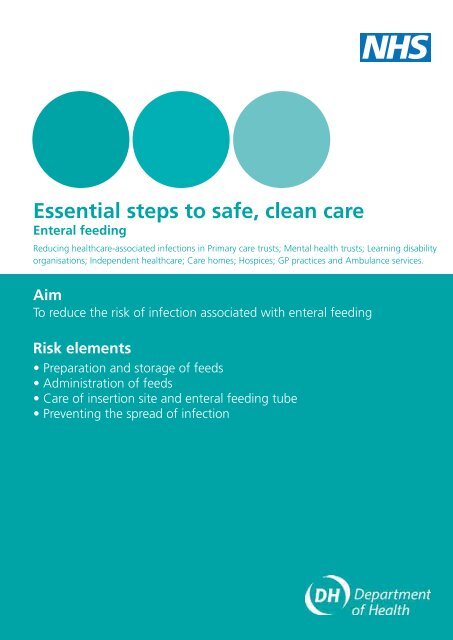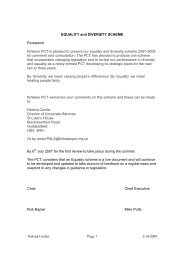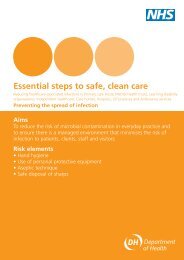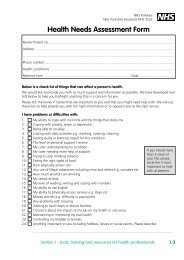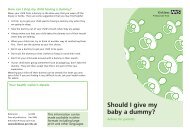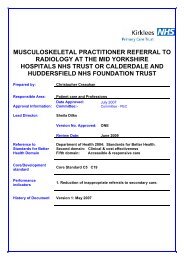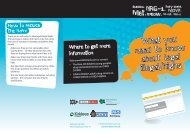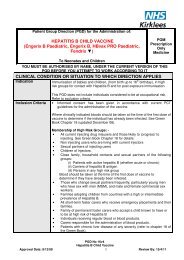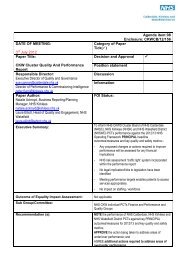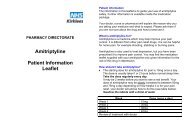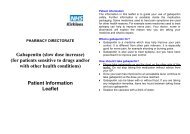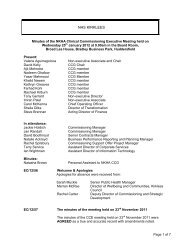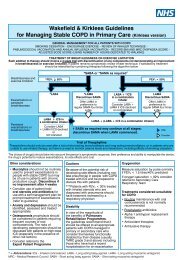Essential steps to safe, clean care - Enteral feeding - NHS Kirklees
Essential steps to safe, clean care - Enteral feeding - NHS Kirklees
Essential steps to safe, clean care - Enteral feeding - NHS Kirklees
Create successful ePaper yourself
Turn your PDF publications into a flip-book with our unique Google optimized e-Paper software.
<strong>Essential</strong> <strong>steps</strong> <strong>to</strong> <strong>safe</strong>, <strong>clean</strong> <strong>care</strong><br />
<strong>Enteral</strong> <strong>feeding</strong><br />
Reducing health<strong>care</strong>-associated infections in Primary <strong>care</strong> trusts; Mental health trusts; Learning disability<br />
organisations; Independent health<strong>care</strong>; Care homes; Hospices; GP practices and Ambulance services.<br />
Aim<br />
To reduce the risk of infection associated with enteral <strong>feeding</strong><br />
Risk elements<br />
• Preparation and s<strong>to</strong>rage of feeds<br />
• Administration of feeds<br />
• Care of insertion site and enteral <strong>feeding</strong> tube<br />
• Preventing the spread of infection
Context<br />
<strong>Enteral</strong> <strong>feeding</strong> means using the gastrointestinal tract for the delivery of<br />
nutrients, which includes eating food, consuming oral supplements and all<br />
types of tube <strong>feeding</strong>. This method of <strong>feeding</strong> has resulted in a range of<br />
different routes and systems for delivery of nutrition, and more patients are<br />
now being fed by home enteral <strong>feeding</strong> tubes in the community setting.<br />
The need for education and training in infection prevention and control is<br />
vital for the provision of the <strong>clean</strong> and <strong>safe</strong> <strong>care</strong> of all enteral <strong>feeding</strong> systems.<br />
The National Institute for Health and Clinical Excellence found that 30% of<br />
feeds were contaminated with a variety of microorganisms, largely due <strong>to</strong> the<br />
poor preparation or poor administration of feeds, (NICE 2003). The research<br />
found that the rates of contamination were highest in home settings and thus<br />
reinforces the need <strong>to</strong> focus on infection prevention and control practices within<br />
the community setting.<br />
These should be read in conjunction with <strong>Essential</strong> <strong>steps</strong> <strong>to</strong> <strong>safe</strong>, <strong>clean</strong> <strong>care</strong>:<br />
Preventing the spread of infection.<br />
Risk elements and <strong>safe</strong>ty actions<br />
The risk elements of the <strong>care</strong> process listed below are based on the NICE<br />
guidelines (NICE, 2003) The risk elements form the basis of reducing the risk<br />
of infection, and the <strong>safe</strong>ty action points indicate how the risk elements should<br />
be carried out.<br />
The list of elements and <strong>safe</strong>ty action points are not meant <strong>to</strong> replace existing<br />
guidelines but <strong>to</strong> act as a simple method for improving the reliability of the<br />
clinical process. Where local guidance and policies already exist, their use in<br />
clinical practice can be assessed by using this intervention, or by tailoring the<br />
review <strong>to</strong>ol <strong>to</strong> meet local needs.<br />
The risk elements are divided in<strong>to</strong> three distinct interventions:<br />
• Preparation and s<strong>to</strong>rage of feeds<br />
• Administration of feeds<br />
• Care of insertion site and enteral <strong>feeding</strong> tube<br />
Education of patients/clients, their <strong>care</strong>rs and health<strong>care</strong> personnel should be<br />
integral <strong>to</strong> all risk elements.<br />
These guidelines should be read in conjunction with the <strong>Essential</strong> <strong>steps</strong> <strong>to</strong> <strong>safe</strong>,<br />
<strong>clean</strong> <strong>care</strong>: Preventing the spread of infection.<br />
Preparation and s<strong>to</strong>rage of feeds<br />
• Feeds should be s<strong>to</strong>red according <strong>to</strong> manufacturers’ instructions and, where<br />
applicable, food hygiene legislation.
Administration of feeds<br />
• Minimal handling and an aseptic non-<strong>to</strong>uch technique should be used <strong>to</strong><br />
connect the feed container administration system and enteral <strong>feeding</strong> tube.<br />
Care of insertion site and enteral <strong>feeding</strong> tube<br />
• The s<strong>to</strong>ma should be washed daily with water and dried thoroughly.<br />
• The enteral <strong>feeding</strong> tube should be flushed with fresh tap water before and<br />
after <strong>feeding</strong> or administrating medications. <strong>Enteral</strong> <strong>feeding</strong> tubes for patients<br />
who are immunosuppressed should be flushed with either cooled freshly boiled<br />
water or sterile water from a freshly opened container.<br />
Preventing the spread of infection<br />
• Refer <strong>to</strong> the <strong>Essential</strong> <strong>steps</strong> <strong>to</strong> <strong>safe</strong>, <strong>clean</strong> <strong>care</strong>: Preventing the spread of infection.<br />
Reference<br />
National Institute for Health and Clinical Excellence (2003) Infection control. Prevention of health<strong>care</strong> associated infection<br />
in primary and community <strong>care</strong>. Department of Health, London. www.nice.org.uk/page.aspx?o=CG002
<strong>Essential</strong> <strong>steps</strong> <strong>to</strong> <strong>safe</strong>, <strong>clean</strong> <strong>care</strong><br />
Reducing health<strong>care</strong>-associated infections in Primary <strong>care</strong> trusts; Mental health trusts; Learning disability<br />
organisations; Independent health<strong>care</strong>; Care homes; Hospices; GP practices and Ambulance services.<br />
<strong>Enteral</strong> <strong>feeding</strong><br />
Preparation and s<strong>to</strong>rage of feeds<br />
• Feeds should be s<strong>to</strong>red according <strong>to</strong><br />
manufacturers’ instructions and, where<br />
applicable, food hygiene legislation.<br />
Administration of feeds<br />
• Minimal handling and an aseptic<br />
non-<strong>to</strong>uch technique should be<br />
used <strong>to</strong> connect the feed container<br />
administration system and enteral<br />
<strong>feeding</strong> tube.<br />
Care of insertion site and enteral <strong>feeding</strong> tube<br />
• The s<strong>to</strong>ma should be washed daily with<br />
water and dried thoroughly.<br />
• The enteral <strong>feeding</strong> tube should be<br />
flushed with fresh tap water before and<br />
after <strong>feeding</strong> or administrating<br />
medications. <strong>Enteral</strong> <strong>feeding</strong> tubes for<br />
patients who are immunosuppressed<br />
should be flushed with either cooled<br />
freshly boiled water or sterile water<br />
from a freshly opened container.<br />
• Education of patients/clients, their <strong>care</strong>rs<br />
and health<strong>care</strong> personnel should be<br />
integral <strong>to</strong> all risk elements.<br />
Preventing the spread of infection<br />
• Refer <strong>to</strong> the <strong>Essential</strong> <strong>steps</strong> <strong>to</strong> <strong>safe</strong>, <strong>clean</strong><br />
<strong>care</strong>: Preventing the spread of infection.
<strong>Enteral</strong> <strong>feeding</strong><br />
Review <strong>to</strong>ol<br />
Name:<br />
Role (of person completing form):<br />
Period of time review was conducted in:<br />
Risk elements How <strong>to</strong> use the review <strong>to</strong>ol<br />
1<br />
2<br />
3<br />
Preparation<br />
and s<strong>to</strong>rage<br />
of feeds<br />
Administration<br />
of feeds<br />
Care of<br />
insertion site<br />
and enteral<br />
<strong>feeding</strong> tube<br />
Preventing<br />
the spread<br />
of infection<br />
Have all<br />
elements been<br />
completed?<br />
Yes/No<br />
Step 1 All staff have had the opportunity <strong>to</strong> look at the<br />
review <strong>to</strong>ol and supporting evidence. They have had time<br />
<strong>to</strong> ask questions and understand why it is being used.<br />
Step 2 A short period of time <strong>to</strong> conduct the series of<br />
observations is determined. The number of observations<br />
needed is determined by the team or individuals involved.<br />
Observations<br />
Step 3 Following direct patient/client contact or procedure,<br />
complete the review <strong>to</strong>ol horizontally. Indicate ‘yes’ when<br />
a risk element has been performed or is considered not<br />
applicable and ‘no’ when it has not been performed.<br />
Step 4 When each observation has been completed,<br />
identify whether all risk elements have been performed.<br />
4<br />
5<br />
Step 5 The aim is for all risk elements <strong>to</strong> be completed<br />
within the <strong>care</strong> process. When this is not being achieved,<br />
score the risk elements vertically on the review <strong>to</strong>ol. This<br />
will help <strong>to</strong> identify which risk elements are not being<br />
performed.<br />
Compliance<br />
for each<br />
risk element<br />
Target:100%<br />
Step 6 Timely feedback should be given, and a change in<br />
actions or practice should be implemented <strong>to</strong> progress<br />
improvement. Refer <strong>to</strong> the risk elements and <strong>safe</strong>ty actions<br />
in the leaflet for evidence <strong>to</strong> support the change in action.<br />
Number of yes scores ÷ Number of observations × 100 = % Compliance for each risk element<br />
In this example, another quick way <strong>to</strong> score is <strong>to</strong> allocate 20 points <strong>to</strong> every yes answer, which will give you a % compliance for each risk element.<br />
275553/D 1p 20K Jun 06 (BEL) – © Crown copyright 2006


